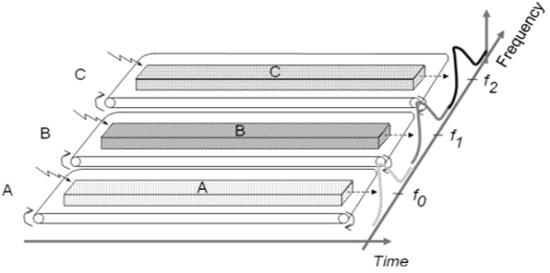
- CDMA Tutorial
- CDMA - Home
- CDMA - Introduction
- CDMA - Channels
- CDMA - Multiple Access Methods
- CDMA - FDMA Technology
- CDMA - TDMA Technology
- CDMA - Technology
- CDMA - Network
- CDMA - Techniques
- CDMA - Spread Spectrum
- CDMA - Fading
- CDMA - Near-Far Problem
- CDMA - Power Control
- CDMA - Frequency Allocation
- CDMA - Handoff
- CDMA - Interferences
- CDMA Questions & Answers
- CDMA - Questions & Answers
- CDMA Useful Resources
- CDMA - Quick Guide
- CDMA - Useful Resources
- CDMA - Discussion
FDMA - Technology
Frequency Division Multiple Access (FDMA) is one of the most common analogue multiple access methods. The frequency band is divided into channels of equal bandwidth so that each conversation is carried on a different frequency (as shown in the figure below).
FDMA Overview
In FDMA method, guard bands are used between the adjacent signal spectra to minimize crosstalk between the channels. A specific frequency band is given to one person, and it will received by identifying each of the frequency on the receiving end. It is often used in the first generation of analog mobile phone.

Advantages of FDMA
As FDMA systems use low bit rates (large symbol time) compared to average delay spread, it offers the following advantages −
Reduces the bit rate information and the use of efficient numerical codes increases the capacity.
It reduces the cost and lowers the inter symbol interference (ISI)
Equalization is not necessary.
An FDMA system can be easily implemented. A system can be configured so that the improvements in terms of speech encoder and bit rate reduction may be easily incorporated.
Since the transmission is continuous, less number of bits are required for synchronization and framing.
Disadvantages of FDMA
Although FDMA offers several advantages, it has a few drawbacks as well, which are listed below −
It does not differ significantly from analog systems; improving the capacity depends on the signal-to-interference reduction, or a signal-to-noise ratio (SNR).
The maximum flow rate per channel is fixed and small.
Guard bands lead to a waste of capacity.
Hardware implies narrowband filters, which cannot be realized in VLSI and therefore increases the cost.